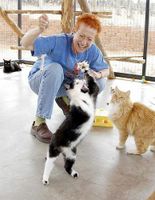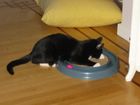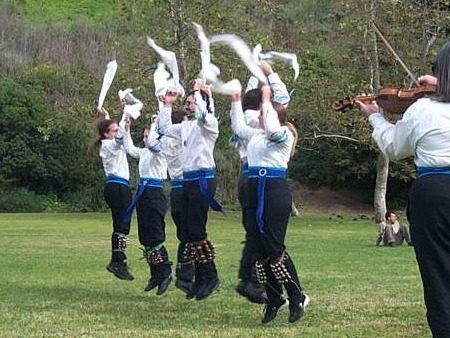Tuesday, May 31, 2005
Delivery
Tonight was the reading for the students in the memoir writing classes that I just finished at the UW Extension Writers Program. For the reading, I reworked a piece that I wrote early in the year. Before taking this class, I had trouble writing multiple drafts. My teacher, Laura Kalpakian, and my classmates have, through their regular critiques of my work, helped me learn about that part of the writing process. Here's the piece that I read this evening:
-------------------------------------------------------------------------------------------
When Paul and I married seven years ago, neither of us knew this sad truth: I can't make a decent latte. Early in our marriage, Paul demonstrated, more than once, the process of transforming dark- roasted coffee beans and cold milk into a steaming, foamy, caffeinated treat. Standing by my side before the black and chrome contraption, he patiently guided me through the process of grinding, filling, tamping, steaming and pouring. The lessons did not take. Oh, I made a latte or two, but my lattes hissed and spit out of the espresso machine either too weak or too bitter. The barista who served me such a latte would not have been tipped.
One morning, when I requested Paul's assistance with the espresso maker yet again, he exclaimed in frustration, "I don't understand why you can't do this. You're good with machines... hell, you understand how most things work without reading the instructions. Do you have some sort of a brain injury?" This question, from the man whose pet name for me is Brains, struck me as absurdly funny. I burst out laughing, and Paul joined me. We stood in our kitchen, hugging each other, giggling.
My supposed 'brain injury' became a recurring joke. Paul would marvel that my injury had impaired only my ability to tamp grounds and steam milk. I would nod in agreement, and comment that the workings of the human brain are not fully understood by modern science.
Once my condition had been identified, Paul shouldered barista duty at our house. Each morning he would bring me a latte in bed. One of the small daily pleasures of my life was waking to the sound of my husband walking into our bedroom, singing this short verse:
In January of 2004, Paul was diagnosed with an oral cancer at the base of his tongue. The surgery to remove the tumor would be long and dangerous, the lasting effects on his speech and swallowing uncertain. A few days before surgery, Paul expressed concern about my morning lattes. "You won't have coffee drink delivery while I'm in the hospital. What will you do? How will you wake up?" While his tone was light, I heard the dark thoughts and real questions beneath the surface of his words: How are you holding up? I'm sorry I'm putting you through this. Are you going to be OK?
I could answer the surface question easily. Finding coffee in Seattle is simple. The espresso bar in the hospital lobby could meet my needs while Paul was hospitalized. We have five coffee shops within as many blocks of our house. I would not suffer from lack of coffee.
I had no answers, simple or otherwise, for the unspoken questions. Too many unknowns waited on the other side of Paul's surgery. Would he survive the surgery, and the cancer, or would I lose him? What toll would his illness and treatment take on him, and on our relationship? I believed that I was coping well, but I knew that might change. I didn't know whether I would be OK.
Several weeks after Paul's surgery, I woke, feeling cold, in our still-dark bedroom. Pulling the down comforter up to my ears, I turned to snuggle up to Paul. The hand I extended landed not across his shoulder, but on soft, warm fur. In an instant, I went from half asleep to worried. Why was Paul up so early? He had been out of bed long enough that our cats had claimed the warm spot against his pillow. Was he feeling ill?
I was about to call out his name when I heard footsteps on the stairs, and caught a whiff of coffee. Relaxing under the comforter's warmth, I waited. Paul's singing wasn't elegant that morning, but it brought tears to my eyes. The latte was the best I've ever tasted, the love with which it was made almost visible in its foamy top.
-------------------------------------------------------------------------------------------
When Paul and I married seven years ago, neither of us knew this sad truth: I can't make a decent latte. Early in our marriage, Paul demonstrated, more than once, the process of transforming dark- roasted coffee beans and cold milk into a steaming, foamy, caffeinated treat. Standing by my side before the black and chrome contraption, he patiently guided me through the process of grinding, filling, tamping, steaming and pouring. The lessons did not take. Oh, I made a latte or two, but my lattes hissed and spit out of the espresso machine either too weak or too bitter. The barista who served me such a latte would not have been tipped.
One morning, when I requested Paul's assistance with the espresso maker yet again, he exclaimed in frustration, "I don't understand why you can't do this. You're good with machines... hell, you understand how most things work without reading the instructions. Do you have some sort of a brain injury?" This question, from the man whose pet name for me is Brains, struck me as absurdly funny. I burst out laughing, and Paul joined me. We stood in our kitchen, hugging each other, giggling.
My supposed 'brain injury' became a recurring joke. Paul would marvel that my injury had impaired only my ability to tamp grounds and steam milk. I would nod in agreement, and comment that the workings of the human brain are not fully understood by modern science.
Once my condition had been identified, Paul shouldered barista duty at our house. Each morning he would bring me a latte in bed. One of the small daily pleasures of my life was waking to the sound of my husband walking into our bedroom, singing this short verse:
Coffee drink delivery service
Coffee drink, if you are nervous
About how youÂre going to wake.
Have yourself a coffee break.
In January of 2004, Paul was diagnosed with an oral cancer at the base of his tongue. The surgery to remove the tumor would be long and dangerous, the lasting effects on his speech and swallowing uncertain. A few days before surgery, Paul expressed concern about my morning lattes. "You won't have coffee drink delivery while I'm in the hospital. What will you do? How will you wake up?" While his tone was light, I heard the dark thoughts and real questions beneath the surface of his words: How are you holding up? I'm sorry I'm putting you through this. Are you going to be OK?
I could answer the surface question easily. Finding coffee in Seattle is simple. The espresso bar in the hospital lobby could meet my needs while Paul was hospitalized. We have five coffee shops within as many blocks of our house. I would not suffer from lack of coffee.
I had no answers, simple or otherwise, for the unspoken questions. Too many unknowns waited on the other side of Paul's surgery. Would he survive the surgery, and the cancer, or would I lose him? What toll would his illness and treatment take on him, and on our relationship? I believed that I was coping well, but I knew that might change. I didn't know whether I would be OK.
Several weeks after Paul's surgery, I woke, feeling cold, in our still-dark bedroom. Pulling the down comforter up to my ears, I turned to snuggle up to Paul. The hand I extended landed not across his shoulder, but on soft, warm fur. In an instant, I went from half asleep to worried. Why was Paul up so early? He had been out of bed long enough that our cats had claimed the warm spot against his pillow. Was he feeling ill?
I was about to call out his name when I heard footsteps on the stairs, and caught a whiff of coffee. Relaxing under the comforter's warmth, I waited. Paul's singing wasn't elegant that morning, but it brought tears to my eyes. The latte was the best I've ever tasted, the love with which it was made almost visible in its foamy top.
Sunday, May 29, 2005
Folklife!
 For many musicians, dancers and craftspeople in the Pacific Northwest, Memorial Day Weekend is all about Seattle's Northwest Folklife Festival. Begun in 1972, the original festival's concept was to provide a public forum where the traditional and ethnic communities and artists of the Northwest Region of the National Park Service (Alaska, Washington, Oregon, Idaho, and Western Montana) could present their music and dance performances and crafts. The theme was presenting what people "make for their own use and do for their own entertainment."
For many musicians, dancers and craftspeople in the Pacific Northwest, Memorial Day Weekend is all about Seattle's Northwest Folklife Festival. Begun in 1972, the original festival's concept was to provide a public forum where the traditional and ethnic communities and artists of the Northwest Region of the National Park Service (Alaska, Washington, Oregon, Idaho, and Western Montana) could present their music and dance performances and crafts. The theme was presenting what people "make for their own use and do for their own entertainment."Thirty-three years later, Folklife is going strong. At the Seattle Center this weekend, from mid-day Friday until Monday evening, over 6,000 musicians, dancers, and visual artists are entertaining and teaching an estimated 250,000 visitors.
I was at Folklife today fiddling for my morris dance team. Tomorrow evening, I'll be playing for a performance of English country dancing (think Jane Austen movies). I'll be back after the Festival's over.
Friday, May 27, 2005
Feline Friday: The Princess

I am a princess... and, yes, you may pet me. Oh, no, I insist.
Thursday, May 26, 2005
Potty parity passes in New York City!
Today's New York Daily News has news women can use:
This new ordinance will change the look of building plans, which have long been designed with back-to-back restrooms providing equal numbers of plumbing fixtures for men and woman along a shared plumbing wall. I imagine that there are already NYC architects at work developing layouts that are similarly efficient, but provide the newly required "potty parity." I'm sure the women of NYC will appreciate their efforts.
It's a go for 'potty parity'
By Frank Lombardi, Daily News City Hall Bureau
There were signs of relief - especially from the ladies - yesterday after the City Council unanimously passed a long-awaited "potty parity" bill.
New buildings and buildings undergoing major renovations will be required to install two toilets for women for every one provided to men.
The current law, enacted in 1984, requires a 1-to-1 ratio. But men can "zoom in and zoom out," while women end up waiting in long lines, noted Councilwoman Madeline Provenzano (D-Bronx), chairwoman of the Housing and Buildings Committee.
"This is a quantum leap into the 21st century," said Councilwoman Yvette Clarke (D-Brooklyn), chief sponsor and architect of the bill.
The bill approved yesterday is a compromise version of a proposal that would have required virtually all buildings - new and old - with public rest rooms to have two facilities for women for every one designated for men.
In a deal with Mayor Bloomberg, the original potty-parity bill was flushed because of complaints over its potentially huge cost to owners of bars, restaurants and theaters and to publicly owned facilities, such as stadiums.
The bill approved yesterday, 50-to-0 with one absentee, mandates the 2-for-1 rule only for new buildings and existing ones that undergo renovations whose costs exceed 50% of the value of the building. The law could take effect as soon as the fall.
"If there was ever a bill I was afraid to be on the wrong side of, it would be this bill," quipped Councilman Erik Martin-Dilan (D-Brooklyn), whose district is 60% female.
This new ordinance will change the look of building plans, which have long been designed with back-to-back restrooms providing equal numbers of plumbing fixtures for men and woman along a shared plumbing wall. I imagine that there are already NYC architects at work developing layouts that are similarly efficient, but provide the newly required "potty parity." I'm sure the women of NYC will appreciate their efforts.
Wednesday, May 25, 2005
What we did on our seventh anniversary
As I wrote elsewhere last year, Paul and I spent our first two wedding anniversaries out of the country, the first in Italy and the second in Canada. We joked after the second trip that we would leave the country each year for our anniversary, but events - some chosen, others forced upon us - have made that playful plan impossible.
For our anniversary this year, we got away for a brief but thrilling adventure. We went to see Star Wars Episode III: Revenge of the Sith.
Paul met me after work on Monday evening, and we walked the several blocks down 4th Avenue from my office to the Cinerama Theater. Built in 1963, Seattle's Cinerama is one of three remaining venues in the world capable of showing three-strip Cinerama movies such as "How The West Was Won" and the 70mm Cinerama classic, "2001: A Space Odyssey." In the late 1990's, the theater was in danger of demolition or conversion into a clumbing club. One of Microsoft's bigwigs - a fan of movies as well as rock music and football - purchased and beautifully restored the theater, which reopened in 1999. I dislike most of this man's grandiose gestures in Seattle, but this is a spectacular movie theater, and I'm glad that he saved it.
We arrived 40 minutes early for the 7:00 p.m. show; already a line of excited fellow travellers snaked halfway around the block. This was not the line to buy tickets, mind you, but the line for ticketholders waiting to get in the door. We'd bought our tickets on Saturday, so we joined on the end of the line.
Twenty minutes later, the line began to feed into the theater. Once in the door, Paul and I made our way up to our favorite spot in this theater: the middle of the balcony. I then headed back to the lobby for treats. I asked Paul what sort of candy he wanted. As neither of us knew what would be available, he told me to choose. When I returned several minutes later, Paul gestured toward a couple of teenagers making calls on their cell phones. "We're an older generation," he said. "After you left, I realized that I could call your cell phone to find out what sort of candy they have... but that just seemed silly." Fortunately, Paul was happy with my selection.
There are plenty of other people writing about this movie, and I'll leave that to them. I will say that we enjoyed the movie very much. We cheered, we hissed, we laughed, we cried (at least I cried a bit, but as Paul will tell you, I cry at anything). We had a wonderful time.
After the movie, we walked back up 4th Avenue to my car. We passed a half-dozen or so of Seattle's young pierced and tattooed, all carrying plastic light sabers, clearly on their way to the next showing. They looked about the same age that Paul and I were when we saw Return of the Jedi in 1983.
As we walked, Paul asked, "Does this count as leaving the country? We did go to a galaxy far, far away." I squeezed his hand, and we laughed.
For our anniversary this year, we got away for a brief but thrilling adventure. We went to see Star Wars Episode III: Revenge of the Sith.
Paul met me after work on Monday evening, and we walked the several blocks down 4th Avenue from my office to the Cinerama Theater. Built in 1963, Seattle's Cinerama is one of three remaining venues in the world capable of showing three-strip Cinerama movies such as "How The West Was Won" and the 70mm Cinerama classic, "2001: A Space Odyssey." In the late 1990's, the theater was in danger of demolition or conversion into a clumbing club. One of Microsoft's bigwigs - a fan of movies as well as rock music and football - purchased and beautifully restored the theater, which reopened in 1999. I dislike most of this man's grandiose gestures in Seattle, but this is a spectacular movie theater, and I'm glad that he saved it.
We arrived 40 minutes early for the 7:00 p.m. show; already a line of excited fellow travellers snaked halfway around the block. This was not the line to buy tickets, mind you, but the line for ticketholders waiting to get in the door. We'd bought our tickets on Saturday, so we joined on the end of the line.
Twenty minutes later, the line began to feed into the theater. Once in the door, Paul and I made our way up to our favorite spot in this theater: the middle of the balcony. I then headed back to the lobby for treats. I asked Paul what sort of candy he wanted. As neither of us knew what would be available, he told me to choose. When I returned several minutes later, Paul gestured toward a couple of teenagers making calls on their cell phones. "We're an older generation," he said. "After you left, I realized that I could call your cell phone to find out what sort of candy they have... but that just seemed silly." Fortunately, Paul was happy with my selection.
There are plenty of other people writing about this movie, and I'll leave that to them. I will say that we enjoyed the movie very much. We cheered, we hissed, we laughed, we cried (at least I cried a bit, but as Paul will tell you, I cry at anything). We had a wonderful time.
After the movie, we walked back up 4th Avenue to my car. We passed a half-dozen or so of Seattle's young pierced and tattooed, all carrying plastic light sabers, clearly on their way to the next showing. They looked about the same age that Paul and I were when we saw Return of the Jedi in 1983.
As we walked, Paul asked, "Does this count as leaving the country? We did go to a galaxy far, far away." I squeezed his hand, and we laughed.
Tuesday, May 24, 2005
Strengthen the Good
Some months ago, I ran across a weblog called Strengthen the Good, which describes its mission thus: "Using the power of weblogs for open-source charity. Don't just fight evil: Strengthen the good." Occasionally, STG highlights what its founder Alan Nelson refers to a micro-charity, "a small, inspiring charity, one with a real face, where $1 makes a difference."
The most recent STG post is about Susan Tom, a single mother raising 13 children, 11 of whom she has adopted, many of whom are handicapped or have chronic diseases. She sounds like a remarkable woman, with an amazing family. Please take a look.
The most recent STG post is about Susan Tom, a single mother raising 13 children, 11 of whom she has adopted, many of whom are handicapped or have chronic diseases. She sounds like a remarkable woman, with an amazing family. Please take a look.
Monday, May 23, 2005
Seven years ago today...

...Paul and I married, at Savannah-Chanel Vineyards in Saratoga, California. One of the readings at our wedding was this excerpt from Anne Morrow Lindbergh's A Gift from the Sea:
A good relationship has a pattern like a dance and is built on some of the same rules. The partners do not need to hold on tightly, because they move confidently in the same pattern, intricate but gay and swift and free, like a country dance of Mozart's. To touch heavily would be to arrest the pattern and freeze the movement, to check the endlessly changing beauty of its unfolding. There is no place here for the possessive clutch, the clinging arm, the heavy hand; only the barest touch in passing. Now arm in arm, now face to face, now back to back - it does not matter which. Because they know they are partners moving to the same rhythm, creating a pattern together, and being invisibly nourished by it.
The joy of such a pattern is not only the joy of creation or the joy of participation, it is also the joy of living in the moment. Lightness of touch and living in the moment are intertwined. One cannot dance well unless one is completely in time with the music, not leaning back to the last step or pressing forward to the next one, but poised directly on the present step as it comes. Perfect poise on the beat is what gives good dancing its sense of ease, of timelessness, of the eternal.
Sunday, May 22, 2005
Music for a Sunday morning
This morning I was at my computer, writing. Prairie Home Companion played on the radio, hovering at the periphery of my awareness. I hummed along when Shetland musicians Ale Möller and Aly Bain (one of my favorite fiddlers, with a pair of gorgeous icy blue eyes) played a couple of beautiful Shetland tunes that I knew, but I was focused on my writing.
A short while later, my mind briefly registered the sound of guitar chords. Then came a voice that demanded my attention, a woman's clear, pure voice singing:
A second female voice joined in, her close harmony floating just below the melody:
With the third verse came a third voice, weaving its way through the other two:
After an instrumental interlude, the three women's voices returned. The first line of this verse mirrored the beginning of the song, but the meaning of 'one voice' was dramatically different:
When the song ended, I was teary-eyed with joy, for both the beauty of the singing and the glorious hopefulness of the song.
These three Canadian singers - Ruth Moody (composer of One Voice), Nicky Mehta and Annabelle Chvostek - are known as the Wailin' Jennys. (Because their music thrills me, and I'm fond of that Texas Outlaw, I'll forgive them the horrible pun of their name.) If I didn't have a rehearsal this Thursday night for a gig at the Northwest Folklife Festival, Paul and I might well be taking a road trip up over the Canadian Border to see them perform in Nelson, BC. I think they'd be worth the trip.
You can listen to One Voice here.
A short while later, my mind briefly registered the sound of guitar chords. Then came a voice that demanded my attention, a woman's clear, pure voice singing:
This is the sound of one voice
One spirit, one voice
The sound of one who makes a choice
This is the sound of one voice.
A second female voice joined in, her close harmony floating just below the melody:
This is the sound of voices two
The sound of me singing with you
Helping each other to make it through
This is the sound of voices two.
With the third verse came a third voice, weaving its way through the other two:
This is the sound of voices three
Singing together in harmony
Surrendering to the mystery
This is the sound of voices three
This is the sound of all of us
Singing with love and the will to trust
Leave the rest behind it will turn to dust
This is the sound of all of us
After an instrumental interlude, the three women's voices returned. The first line of this verse mirrored the beginning of the song, but the meaning of 'one voice' was dramatically different:
This is the sound of one voice
One people, one voice
A song for every one of us
This is the sound of one voice
This is the sound of one voice
When the song ended, I was teary-eyed with joy, for both the beauty of the singing and the glorious hopefulness of the song.
These three Canadian singers - Ruth Moody (composer of One Voice), Nicky Mehta and Annabelle Chvostek - are known as the Wailin' Jennys. (Because their music thrills me, and I'm fond of that Texas Outlaw, I'll forgive them the horrible pun of their name.) If I didn't have a rehearsal this Thursday night for a gig at the Northwest Folklife Festival, Paul and I might well be taking a road trip up over the Canadian Border to see them perform in Nelson, BC. I think they'd be worth the trip.
You can listen to One Voice here.
I love Seattle in the Springtime...

A little good olive oil + 9-10 minutes in a 475 degree oven + a splash of balsamic vinegar = the taste of Spring.
Friday, May 20, 2005
Feline Friday: Wanted


Be on the lookout for Slasher McKitten, evil twin of Sasha 'Bear' McKitten. Last seen on Thursday, May 19, during the Crating of the McKittens for the annual Veterinary Adventure.
 When Paul mistakenly picked up Slasher, and attempted to place him in Sasha's cat carrier, Slasher lived up to his name. Paul received several scratches, including this one. Fortunately, none were life-threatening, and Paul is convalescing comfortably. During the course of the altercation, Slasher made his escape. His whereabouts are unknown.
When Paul mistakenly picked up Slasher, and attempted to place him in Sasha's cat carrier, Slasher lived up to his name. Paul received several scratches, including this one. Fortunately, none were life-threatening, and Paul is convalescing comfortably. During the course of the altercation, Slasher made his escape. His whereabouts are unknown.A short while later, Sasha was located, hiding in a closet. Though distressed by his evil twin's outburst, the gentle, timid Sasha was coaxed into his cat carrier, and delivered to the tender care of the vet.
The McKitten family is looking forward to a quiet weekend at home.
----------------------------------------------------------------------------
Friday Ark is up! And Carnival of the Cats this week is at the home of its founder.
Thursday, May 19, 2005
How to photograph a building
 You, too, can take stunning photographs of buildings!
You, too, can take stunning photographs of buildings!Just follow these simple guidelines:
1. Select a building with a western exposure. Unless you are at the north or south pole, this is not difficult to do. If the building you choose - for example, this nice turn of the (last) century house - is attractive or interesting, all the better. It is not, however, necessary.
2. On the day of your shoot, arrange with the higher power of your choice for a downpour. The proportions of said downpour should be your higher power's equivalent of Biblical. After the building, surrounding plants and air have been thoroughly washed, ask your higher power to move those storm clouds off to the east, but not too far.
3. Next, order up a sunny evening. If your higher power does not do sun, you may have to find another vendor. (Some higher powers may object to your making a agreement with those they see as competitors. Review your theology with regard to covenants and non-competes.) Verify when you place your order that the sunshine will be hitting the building almost horizontally at the time of the shoot.
4. If you have properly coordinated with the powers that be, you will have an optimal setting for a fine architectural photograph: building and plants glowing in warm evening light, and a dark, brooding sky beyond. It helps, of course, if you can hold the camera steady; consider asking your significant other not to bring the wine until after the shoot.
5. If you are very lucky, your higher power may throw in a rainbow. It never hurts to ask. You might even get two.


Wednesday, May 18, 2005
Revenge of the Spellchecker
Computerized spellchecking was designed to improve our lives.
Sadly, one never knows when a spellchecker, like any technology, may be turned to the Dark Side. Many humans are no match for the spellchecker, and can be swayed by its evil suggestions. In today's Seattle PI review of Star Wars Episode III: Revenge of the Sith, the spellchecker struck back:
A druid army? Would this review have us believe that the members of Earth's ancient Celtic priesthood were descendants of those who lived a long, long time ago, in a galaxy far, far away?
In fact, it is a droid army that is threatening Coruscant in Episode III. Droid, a word that any self-respecting piece of computer software - or any human copyeditor proofreading a Star Wars review - should know.
As Yoda might say, the spellchecker is not stronger. No. Quicker, easier, more seductive... but not stronger.
Sadly, one never knows when a spellchecker, like any technology, may be turned to the Dark Side. Many humans are no match for the spellchecker, and can be swayed by its evil suggestions. In today's Seattle PI review of Star Wars Episode III: Revenge of the Sith, the spellchecker struck back:
"From here, the movie whisks us to the city world of Coruscant, where the increasing threat of the Separatist druid army inspires the war-weary Senate to hand over its power to a dictator, and a coup is in the works that will transform the Republic into the evil Galactic Empire."
A druid army? Would this review have us believe that the members of Earth's ancient Celtic priesthood were descendants of those who lived a long, long time ago, in a galaxy far, far away?
In fact, it is a droid army that is threatening Coruscant in Episode III. Droid, a word that any self-respecting piece of computer software - or any human copyeditor proofreading a Star Wars review - should know.
As Yoda might say, the spellchecker is not stronger. No. Quicker, easier, more seductive... but not stronger.
Monday, May 16, 2005
A best friend to animals in need
 Our cats have a wonderful catsitter, and Paul and I a fine friend, in a slight, red-headed woman named Lynne Madrigal. Whether you call it luck, or serendipity, or the hand of the Almighty, finding Lynne and getting to know her has been one of the truly good things about living in Seattle.
Our cats have a wonderful catsitter, and Paul and I a fine friend, in a slight, red-headed woman named Lynne Madrigal. Whether you call it luck, or serendipity, or the hand of the Almighty, finding Lynne and getting to know her has been one of the truly good things about living in Seattle.Recently, Lynne and a friend went on "vacation" at the Best Friends Animal Society, an animal sanctuary in the Canyon Country of Utah. I had not heard of Best Friends before, and am moved by the work that they do to provide a home for animals in need. And I am once again impressed with Lynne's love for and devotion to cats - not just her own beloved cats, or her clients (that would be our cats, not us), but all cats.
Lynne wrote an article , published today in the Seattle Times, about her time at Best Friends:
KANAB, Utah — Red rock. Blue sky. Cats and dogs, horses and bunnies — creatures once homeless, abused, injured or abandoned — bask in the splendor of Utah's Canyon Country, the home of Best Friends Animal Sanctuary.
Such is the sight that greets me this spring Sunday (my birthday, in fact) the first of four days my friend Claudia Dannettell and I will spend volunteering at Best Friends. We are among more than 4,000 animal lovers who come here each year from all over the world, using precious vacation time doing what we love: petting, brushing and tending to animals. The sanctuary is home to 1,500 dogs, cats, horses, burros, birds, farm and wild animals, so there's no shortage of critters needing our attention.
Occupying 33,000 acres in Angel Canyon, the sanctuary is operated by Best Friends Animal Society, an organization that works with shelters, rescue groups and about 250,000 members throughout the country, and sometimes beyond, to further its mission: No more homeless pets.
Later in the article, Lynne describes a day in the life of a feline-loving volunteer:
The next morning, I report for duty to the cat headquarters. I am assigned to Benton's House, another building for ailing cats, those with kidney disease, skin cancer and other illnesses.
There's hard work to be done here: Floors and tables, windowsills and colorful cubbyholes ascending the walls must be thoroughly cleaned and disinfected. The vast outside enclosure needs sweeping.
During break, I meet two other volunteers: Mary and Karen, both from Pittsburgh, both spending part of their vacations as well. "I want to be a part of helping the animals," Karen says. "This place is an inspiration."
After lunch, I ask at headquarters which cats are least visited by guests and volunteers. They send me to Mondrian's, home of the feral and semi-feral population, intermixed with some "friendlies."
Many of the dozens of cats there are afraid to approach, but others cautiously inch toward me, lured by the brush in my hand. Photos of every cat are posted on the wall, so I am able to address each by name as I groom and cuddle more than 20 needy cats.
Outside, a group of caretaker employees gathers on a break, telling us how happy they are that we are there.
"Volunteers are our bread and butter," says staffer Cathie Toops. Brooke Hodges chimes in, "We don't always have time for the loving and brushing part that volunteers provide."
Later, I visit Jill's Diner, where there are rooms for elderly and diabetic cats, and cats with FIV. At every turn, angel-faced beauties clamor for lap space. I spend the rest of the day here.
Read the rest of Lynne's article here.
Saturday, May 14, 2005
Coffee date... with a laptop
 You see them in all the coffee houses in Seattle, folks sitting alone at small tables with their size/ caffeination/ milkfat(or soy)/ flavor of choice coffee drinks... and their laptops. On occasion you'll find them in pairs, sharing that small table; they have eyes only for the LCD displays nestled cozily back to back. Sometimes they outnumber the people *gasp* talking to one another.
You see them in all the coffee houses in Seattle, folks sitting alone at small tables with their size/ caffeination/ milkfat(or soy)/ flavor of choice coffee drinks... and their laptops. On occasion you'll find them in pairs, sharing that small table; they have eyes only for the LCD displays nestled cozily back to back. Sometimes they outnumber the people *gasp* talking to one another.I've never understood this phenomenon. Why choose a public place to use your computer? What is the appeal of working in a place in which other people are chatting, laughing, coming and going... having a social life?
Today, for the first time, I was one of those folks, and now I understand.
I'd let most of the week pass without starting the writing assignment that is due when my memoir class meets on Tuesday. Ten to fifteen pages, double spaced, to be critiqued by my teacher and all of my classmates. Every time that I sat down to write, I became distracted. The mountains (perhaps I exaggerate) of clutter in my office taunted me. A cat twined through my legs, purring, or poked a couple of too-sharp claws (doesn't anyone ever clip them? oh, right, my job...) into my thigh, while complaining loudly of neglect. And the internets, oh, the internets, sweetly calling to me through our broadband connection, their siren song luring me from one blog, one website, to another, then another.
Finally, last night, I was desperate. I need to get out of the house, I told Paul, away from all these distractions, so I can focus on writing. I asked to borrow his Mac laptop. Of course, I know that wireless internet connections are available in every self-respecting coffee house in this city. I don't know how to connect Paul's iBook to a wireless network, and I asked him not to show me.
This afternoon, I took the laptop to my favorite neighborhood coffee place. I scored the last table in the front window, overlooking the street. I bought a coffee drink (tall lowfat cafe con leche) and a macaroon. After a few minutes of settling in, I started writing. The regular low buzz of music and conversation was a comfortable background, not nearly as distracting as I'd always imagined it would be. None of it was directed at me, and while I occasionally found myself paying attention to a dog outside the window or a ringing cell phone, I also found that I could easily refocus on writing. Three hours and 4 1/2 pages later, I packed up the computer and came home.
I may have to get my own laptop. And don't be surprised if you see me becoming a regular at one of those small coffee house tables. I'll probably notice (if briefly) that you're there, but don't expect me to talk.
I feel so twenty-first century.
Friday, May 13, 2005
Something's Gotta Give
WARNING: This post has been deemed too complicated by some weekend viewers. Brains have been scrambled. Thinking caps have been broken. You have been warned.
I'm going to ask a personal question: What percentage of your income do you pay for housing? I'm not asking because I want to know, but because I want you to know. Here's the calculation: Along with your mortgage or rent payments, include in the numerator of this equation the cost of your household utilities and, if you are a homeowner, your property taxes. Your adjusted gross income, rather than your take-home pay, goes in the denominator. Calculate the percentage, but don't tell me your number yet.
If you are paying up to 30% of your income, your housing is considered to be affordable for you.
If you are paying over 50% of your income for housing, you have a "severe housing cost burden." And, if yours is a "working family" - one working the equivalent of a full-time job and earning anywhere from the federal minimum wage of $10,700 up to 120% of your area's median income - there are lots of housing researchers who are studying, and worrying about, families just like yours... and mine.
The area median income in King County, Washington, is $63,120 for a family of two. Not many architects around here make more than 120% of that amount. (When architects who design affordable housing joke that we're designing for ourselves, we're not always joking.) And, having done that little affordability calculation myself, I see that Paul and I are paying between 30% and 40% of our income for our old house. Our housing is not quite considered to be "affordable" for us, but neither are we "severely burdened."
Two weeks ago, the Center for Housing Policy released a study on housing affordability in the United States called Something's Gotta Give: Working Families and the Cost of Housing. The study begins:
To answer these questions, researchers looked at the federal government’s Consumer Expenditure Survey, which provides "line items" of household budgets — the shares of income and expenditures spent on housing and other necessities. A study of the 2002 National Survey of America’s Families provided an in-depth look at the "bottom line" of how individual families are affected by high housing costs. These studies were supplemented by a focus group of working families from around the country.
So what did the researchers find? Working families that pay more that half of their income for housing are, not surprisingly, reducing expenditures for other essentials: food, clothing, health care. The greatest reduction in spending is for transportation.
These are interesting statistics. One family pays 50% of household expenditures for housing and 7% for transportation; another family pays 30% for housing and 24% for transportation. These families are paying 57% and 54%, respectively, for housing and transportation. Is one family really doing any better financially than the other?
This bears repeating: For almost half of America's working families, paying for housing and transportation takes more than half of their monthly financial resources.
Because my office is only 1.5 miles from our house, Paul and I don't have car payments, and we don't drive long distances regularly, our transportation costs are fairly low. How much does the cost of commuting and other transportation add to your family's "fixed" monthly expenses? Is the length of your commute related at all to the cost of your housing?
I haven't finished reading all of the methodology and conclusions of the report. More on that later.
I'm going to ask a personal question: What percentage of your income do you pay for housing? I'm not asking because I want to know, but because I want you to know. Here's the calculation: Along with your mortgage or rent payments, include in the numerator of this equation the cost of your household utilities and, if you are a homeowner, your property taxes. Your adjusted gross income, rather than your take-home pay, goes in the denominator. Calculate the percentage, but don't tell me your number yet.
If you are paying up to 30% of your income, your housing is considered to be affordable for you.
If you are paying over 50% of your income for housing, you have a "severe housing cost burden." And, if yours is a "working family" - one working the equivalent of a full-time job and earning anywhere from the federal minimum wage of $10,700 up to 120% of your area's median income - there are lots of housing researchers who are studying, and worrying about, families just like yours... and mine.
The area median income in King County, Washington, is $63,120 for a family of two. Not many architects around here make more than 120% of that amount. (When architects who design affordable housing joke that we're designing for ourselves, we're not always joking.) And, having done that little affordability calculation myself, I see that Paul and I are paying between 30% and 40% of our income for our old house. Our housing is not quite considered to be "affordable" for us, but neither are we "severely burdened."
Two weeks ago, the Center for Housing Policy released a study on housing affordability in the United States called Something's Gotta Give: Working Families and the Cost of Housing. The study begins:
Something’s Gotta Give: But What?
Struggling with severe housing cost burdens is not supposed to be so commonplace. General rules of thumb for housing say that about one-third of income is what most working families can afford. But at last count, at least 13 million families in America paid more than half their income for housing and more than 4 million of these families worked full-time jobs.
Yet, we may be underestimating the extent of the problem. Housing is usually the largest and least flexible item in the family budget. How do working families — i.e., those that earn between minimum wage and 120 percent of local median income — cope with high housing costs? Do they put off buying food or healthcare and other necessities? Do they run up a mountain of debt? Do they live long distances from work? And if working families are devoting so much of their expenditures on housing, or on housing plus transportation, what does this mean for the quality of life of these families, especially their children?
To answer these questions, researchers looked at the federal government’s Consumer Expenditure Survey, which provides "line items" of household budgets — the shares of income and expenditures spent on housing and other necessities. A study of the 2002 National Survey of America’s Families provided an in-depth look at the "bottom line" of how individual families are affected by high housing costs. These studies were supplemented by a focus group of working families from around the country.
So what did the researchers find? Working families that pay more that half of their income for housing are, not surprisingly, reducing expenditures for other essentials: food, clothing, health care. The greatest reduction in spending is for transportation.
Working families that spend more than half their total household expenditures on housing put 7.5 percent of their expenditures toward transportation. Contrast this with working families in affordable housing spending 30 percent or less of their total expenditures. Their expenditure shares for transportation are more than three times higher, or nearly 24 percent of their household budget.
These are interesting statistics. One family pays 50% of household expenditures for housing and 7% for transportation; another family pays 30% for housing and 24% for transportation. These families are paying 57% and 54%, respectively, for housing and transportation. Is one family really doing any better financially than the other?
Commuting is a common strategy for working families to cope with high housing costs. When the cost of transportation is considered together with the cost of housing, the percentage of working families paying more than half their total expenditures increases five-fold from 8.3 percent to 44.3 percent of working families. Calculations show that working families spend 77 cents on transportation for every dollar decrease in housing costs. Although not all of family transportation cost is attributable to commuting, the journey to work from less expensive housing likely accounts for a substantial part of it.
This bears repeating: For almost half of America's working families, paying for housing and transportation takes more than half of their monthly financial resources.
Because my office is only 1.5 miles from our house, Paul and I don't have car payments, and we don't drive long distances regularly, our transportation costs are fairly low. How much does the cost of commuting and other transportation add to your family's "fixed" monthly expenses? Is the length of your commute related at all to the cost of your housing?
I haven't finished reading all of the methodology and conclusions of the report. More on that later.
Feline Friday: Hangin' ten
 Sasha is fond of places that are too small for his full-grown size. He loves the ironing board. Yes, he prefers the narrow end, which is not wide enough to support all of him. So, he drapes his beautiful stripey front legs and his fluffy plume of tail over the edge, and uses his hind legs for balance.
Sasha is fond of places that are too small for his full-grown size. He loves the ironing board. Yes, he prefers the narrow end, which is not wide enough to support all of him. So, he drapes his beautiful stripey front legs and his fluffy plume of tail over the edge, and uses his hind legs for balance.Sometimes, having ironed a shirt to wear to work, I discover that I have traded the wrinkles in the fabric for several small tufts of fine, soft, grayish fur. When I am lucky, I discover this while I am still at home.
Note to self: buy fur removal device for car and/or office.
There are lots more animals at the Friday Ark. Carnival of the Cats is up at Aptenobytes, and Sasha is thrilled to be included with so many gorgeous cats.
Wednesday, May 11, 2005
Choose your own deity
Have you found that the organized religions you've tried just haven't worked for you? Perhaps the right spiritual home for you is in this new church:
Scientology Losing Ground to New FictionologyRead the rest of the story here.
LOS ANGELES—According to a report released Monday by the American Institute of Religions, the Church of Scientology, once one of the fastest-growing religious organizations in the U.S., is steadily losing members to the much newer religion Fictionology.
"Unlike Scientology, which is based on empirically verifiable scientific tenets, Fictionology's central principles are essentially fairy tales with no connection to reality," the AIR report read. "In short, Fictionology offers its followers a mythical belief system free from the cumbersome scientific method to which Scientology is hidebound."
Tuesday, May 10, 2005
Muppet memories
 I heard on NPR yesterday morning that it was Kermit the Frog's 50th birthday. Until yesterday, I had no idea that Kermit is older than I am. My, he's aging well. Jim Henson created the characters of Kermit and other proto-muppets as part of Sam and Friends, a five-minute live show that aired on WRC-TV in Washington, D.C., from 1955 to 1961. In his first appearances, Kermit looked more lizard than frog; by the debut of Sesame Street in 1969, he had become his amphibious green self.
I heard on NPR yesterday morning that it was Kermit the Frog's 50th birthday. Until yesterday, I had no idea that Kermit is older than I am. My, he's aging well. Jim Henson created the characters of Kermit and other proto-muppets as part of Sam and Friends, a five-minute live show that aired on WRC-TV in Washington, D.C., from 1955 to 1961. In his first appearances, Kermit looked more lizard than frog; by the debut of Sesame Street in 1969, he had become his amphibious green self.While the Muppets figured prominently in many people's childhoods, Kermit and the Muppet Show evoke strong memories of my final semester in college. The Muppet Show had been cancelled the previous year, but a local Providence station played reruns every evening at 7:00 p.m., right about the time that my roommates and I finished dinner.
We were having a horrific year. My boyfriend (now husband) Paul had been diagnosed with non-Hodgkin's lymphoma the week after Thanksgiving, and was home in Connecticut in chemotherapy. Becca had a breast tumor, which fortunately was benign, and recurring UTI's in part, she eventually learned, because of kidney malformations. Chris had mysteriously become quite anemic; Barrett and Lynda had mono for a month. (How I stayed healthy though this period I'll never know.) The news from our apartment was so consistently bad that one roommate's insensitive (and not surprisingly temporary) boyfriend christened it the "death suite." (He also called us castrating bitches, which somehow struck us as funny; we took to calling our apartment the CB suite, and ourselves the CB's.)
 Dinnertime with my roommates was often the best part of the day. We took turns cooking, then gathered around the dinner table for nourishment both physical and emotional. At the end of dinner each weeknight, the five of us were joined by our friends, the Muppets. Stacking the dinner dishes in the middle of the table, we'd pour toasted almonds (kahlua, amaretto and milk) or sea breezes (vodka and cranberry juice, particularly popular when UTI's struck), turn on our small TV, and give ourselves over to the antics of Kermit, Miss Piggy, their friends and special (human) guests stars. We particularly loved the Swedish Chef, seen here in the classic chocolate moose sketch, and would sing along with his Swedish gibberish song, ending with a heartfelt, "Børk! Børk! Børk!" Half an hour of gentle laughter therapy, and we'd head back to our books for the evening.
Dinnertime with my roommates was often the best part of the day. We took turns cooking, then gathered around the dinner table for nourishment both physical and emotional. At the end of dinner each weeknight, the five of us were joined by our friends, the Muppets. Stacking the dinner dishes in the middle of the table, we'd pour toasted almonds (kahlua, amaretto and milk) or sea breezes (vodka and cranberry juice, particularly popular when UTI's struck), turn on our small TV, and give ourselves over to the antics of Kermit, Miss Piggy, their friends and special (human) guests stars. We particularly loved the Swedish Chef, seen here in the classic chocolate moose sketch, and would sing along with his Swedish gibberish song, ending with a heartfelt, "Børk! Børk! Børk!" Half an hour of gentle laughter therapy, and we'd head back to our books for the evening.Happy birthday, Kermie. And thank you, Jim Henson, for lifting the hearts of several very sad, stressed out college students, many years ago.
Monday, May 09, 2005
Fresh each day
The past couple of weeks, I haven't have much time to read blogs - or, obviously, to write much here. The rest of my life has been busy, and in good ways. Now I just have to figure our how to have a busy life, read the blogs I love, and write here regularly.
On days when I have little time to spend in the blogosphere, there are two blogs that I almost always visit, because they provide such lovely small treats for the eyes.
Postcard from Provence is the daily painting blog of Julian Merrow-Smith, a British (really, didn't the name tell you?) painter living in Crillon-le-Brave, Provence with his wife, cellist Ruth Phillips, and their two cats. Since February 16, Julian has been painting, and posting, a small oil painting each day on this blog. His still lives - often one piece of luscious local fruit such as those shown here - are mouth-watering; his landscapes sketches capture in gesture the qualities of light, shade and shadow on the buildings and trees of Provence. Julian writes:


I first learned of painter Duane Keiser's blog, A Painting a Day, from a post of Ruth's. It has become a daily "read" as well. Duane, who lives in Richmond, Virginia, says this about his blog:
Duane paints small still lives, not only of small, ovoid foods, but of flowers, fishing lures, even the proverbial silver spoon (shown out of mouth). Yesterday, he posted the sweet, light-filled 'Backyard (for Mom)'. Duane has a great short movie showing him painting a small object. How long did it take you to figure out what he was painting?


Were it not for Ruth, who somehow found Music and Cats and wrote to me, I would probably not know of either of these painting blogs, nor would I know of her own thoughtful, lyrical, beautifully written blog, meanwhile, here in france... Many thanks, Ruth.
On days when I have little time to spend in the blogosphere, there are two blogs that I almost always visit, because they provide such lovely small treats for the eyes.
Postcard from Provence is the daily painting blog of Julian Merrow-Smith, a British (really, didn't the name tell you?) painter living in Crillon-le-Brave, Provence with his wife, cellist Ruth Phillips, and their two cats. Since February 16, Julian has been painting, and posting, a small oil painting each day on this blog. His still lives - often one piece of luscious local fruit such as those shown here - are mouth-watering; his landscapes sketches capture in gesture the qualities of light, shade and shadow on the buildings and trees of Provence. Julian writes:
The idea for this site germinated over the winter of 2004/2005, in no small measure due to the arrival of ADSL in the provençal countryside, my interest in webdesign, webstandards and blogging and finally, stumbling across the enormously successful site of one Duane Keiser.


I first learned of painter Duane Keiser's blog, A Painting a Day, from a post of Ruth's. It has become a daily "read" as well. Duane, who lives in Richmond, Virginia, says this about his blog:
For this blog I'm going to try to make a painting each day (starting 12/10/2004.) Most of the paintings on this blog will be postcard-sized oil sketches (I call them Postcard Paintings.) I paint them on site, using a modified cigar box as an easel.
Duane paints small still lives, not only of small, ovoid foods, but of flowers, fishing lures, even the proverbial silver spoon (shown out of mouth). Yesterday, he posted the sweet, light-filled 'Backyard (for Mom)'. Duane has a great short movie showing him painting a small object. How long did it take you to figure out what he was painting?


Were it not for Ruth, who somehow found Music and Cats and wrote to me, I would probably not know of either of these painting blogs, nor would I know of her own thoughtful, lyrical, beautifully written blog, meanwhile, here in france... Many thanks, Ruth.
Friday, May 06, 2005
Feline Friday: Herb 2
When Paul and I travel, our cats Lyra, Sasha and Sergei are in for a treat. Our catsitter, their Auntie Lynne, comes each day to feed them, play with them, sometimes even nap with them. If we are gone for more than a couple of days, we usually return home to find that the cats have a new toy.
The Christmas before last, this wonderful scratching-pad-with-ball-toy was the cats' treat from Lynne. The pink ball cannot come out of the track, but the cats seem not to understand that, and have a great time batting at it, watching it spin around the ring. The scratching pad is the corrugated cardboard sort, and came with a baggie of catnip for enticing the cats to use it. Works like a charm, as Sergei and Sasha demonstrate in these photos, taken hours ago, just after I'd applied a liberal amount of catnip to the pad.












Sometimes late at night, when the house is very quiet, I'll suddenly hear the sound of that pink ball spinning around the track. WhirrrrrWhirrrrWhirrrr...
The Christmas before last, this wonderful scratching-pad-with-ball-toy was the cats' treat from Lynne. The pink ball cannot come out of the track, but the cats seem not to understand that, and have a great time batting at it, watching it spin around the ring. The scratching pad is the corrugated cardboard sort, and came with a baggie of catnip for enticing the cats to use it. Works like a charm, as Sergei and Sasha demonstrate in these photos, taken hours ago, just after I'd applied a liberal amount of catnip to the pad.












Sometimes late at night, when the house is very quiet, I'll suddenly hear the sound of that pink ball spinning around the track. WhirrrrrWhirrrrWhirrrr...
Wednesday, May 04, 2005
The Reading
If you were to scroll down to near the bottom of the May author events page at the University of Washington Bookstore's web site, you'd see this:
The listing has gotten several things wrong. Of course I'll tell you what they are; otherwise I'll be bothered by them. It's the only night of our class readings. Whatever we've been "up to," it has been all year. UW doesn't have semesters; it has quarters... and this is our third one.
So what's this all about? As the "final project" for our certificate program, my classmates and I will be reading 4-5 minute excerpts from our work for anyone who wants to come and listen.
My classmates' memoir topics vary considerably. A is writing about working with Washington's first openly gay state legislator, B about her lovely, loving family, and her journey to become a female, African-American doctor, C about her Peace Corps experience in Mongolia, D about post-traumatic stress... and those are only four of nineteen. The writing styles vary considerably, but through the course of the year, each person has come to "sound" on paper more and more the way that they sound when speaking; everyone's voice is becoming much more clear.
I've been puzzling over what to read at this event. A 4-5 minute reading is about 1 manuscript page, 12 point, single spaced. Most everything that I've written for the class has been much longer than that, and I'm not sure how to edit specifically for this reading. We're going to talk about that very thing at next week's class; I hope to have a better idea about this a week from now.
If you're going to be in Seattle on May 31, and don't have any plans for the evening, come on over to the UW Bookstore. It should be an interesting evening.
Tuesday May 31 7pm
Laura Kalpakian's Memoir Class Reading
University District Store
Tuesday is the first night of Laura Kalpakian's UW Extension Memoir class student readings. Come see what they've been up to all semester.
The listing has gotten several things wrong. Of course I'll tell you what they are; otherwise I'll be bothered by them. It's the only night of our class readings. Whatever we've been "up to," it has been all year. UW doesn't have semesters; it has quarters... and this is our third one.
So what's this all about? As the "final project" for our certificate program, my classmates and I will be reading 4-5 minute excerpts from our work for anyone who wants to come and listen.
My classmates' memoir topics vary considerably. A is writing about working with Washington's first openly gay state legislator, B about her lovely, loving family, and her journey to become a female, African-American doctor, C about her Peace Corps experience in Mongolia, D about post-traumatic stress... and those are only four of nineteen. The writing styles vary considerably, but through the course of the year, each person has come to "sound" on paper more and more the way that they sound when speaking; everyone's voice is becoming much more clear.
I've been puzzling over what to read at this event. A 4-5 minute reading is about 1 manuscript page, 12 point, single spaced. Most everything that I've written for the class has been much longer than that, and I'm not sure how to edit specifically for this reading. We're going to talk about that very thing at next week's class; I hope to have a better idea about this a week from now.
If you're going to be in Seattle on May 31, and don't have any plans for the evening, come on over to the UW Bookstore. It should be an interesting evening.
Sunday, May 01, 2005
Fit as a morris for May-day
COUNTESS: Will your answer serve fit to all questions?
CLOWN: As fit as ten groats is for the hand of an attorney,
as your French crown for your taffeta punk,
as Tib's rush for Tom's forefinger,
as a pancake for Shrove Tuesday, a morris for May-day,
as the nail to his hole, the cuckold to his horn,
as a scolding queen to a wrangling knave,
as the nun's lip to the friar's mouth,
nay, as the pudding to his skin.
--William Shakespeare, All's Well that Ends Well, Act II scene ii
For the past 10 years, I've spent the early hours of May Day at one windy waterside park or another, playing fiddle while my Morris-dancing friends dance up the sun. How the sun manages to rise unassisted the other 364 days of the year is a question for another day. On this day, Morris sides around the world do their part to assist the sun on its path.
Nineteen hours before Seattle's dancers are due at Gasworks Park, dancers in Auckland, New Zealand, get the day started. Dressed in whites, ribbons and bells, they meet at the top of Mt. Eden to raise the sun. As it's now autumn in the southern hemisphere, dawn comes at around 7:00 a.m. in Auckland. Lucky Kiwis! Morris sides exist primarily in countries with large populations of English descent or large British expatriate communities. After New Zealand, teams in Australia, Hong Kong and South Africa help to send the sun on its way west. England's many Morris teams pass the sun on to the Americans - both US and Canadian.
By the time the sun makes it to the west coast of North America, it's almost done for the day. Still, to ensure that the sun keeps going across the Pacific and back to New Zealand again (after which it's on its own again until next year), Morris sides from southern California to Vancouver, BC participate in sun-raising. I noted last May Day that, "in Seattle, 'dancing up the sun' is usually a conceptual exercise...It's dark, cold, windy, and often drizzling, if not outright raining... The first team that has a full complement of dancers starts the dancing a few minutes before what we know intellectually to be dawn, and we dance until the sky has lightened enough that we can believe that the sun is, in fact, above the horizon."
Like last year, however, this May Day morning was glorious. A bright half moon was high in the mostly clear, already lightening sky as Paul and I drove to Gasworks Park. Arriving at 5:30 a.m., we discovered that we were the first of the Morris folk there. (A few of the pagans who always come out for May Day dawn had arrived; they care much more about being out right at sunrise than do most dancers.) The dancers reached critical mass in time to do one dance before sunrise on the clock. The Cascade mountains and the I-5 bridge hid the sun for an additional ten minutes, so we saw "sunrise" at a few minutes after 6:00 a.m. After an hour and a half of dancing, the sun was well up in the sky. Our work was done, and we were off to Mae's for breakfast... and lots of coffee.



 Music and Cats
Music and Cats